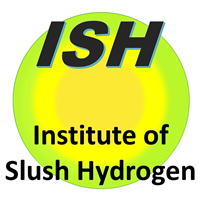Development of the high-efficiency hydrogen energy system using slush hydrogen

Anticipated applications for slush hydrogen* include fuel cells, rocket
and space-plane fuels, and refrigerant for high-temperature superconducting
(HTS) equipment. With the rapid popularization of fuel cells, increasing
demand for electrical power due to the rise of information technology,
and the need to reduce greenhouse gas emissions [1, 2] **, Institute of Slush Hydrogen (ISH) has originally proposed the high-efficiency
hydrogen energy system using slush hydrogen, and has been engaged in related technological development work as illustrated
in the above figure [3-5].
When hydrogen is transported in the form of slush through long-distance
pipelines, in combination with the HTS electrical power transmission using
magnesium diboride (MgB2) ***, and the high-temperature superconducting magnetic energy storage
(SMES) at the terminal with liquid**** or slush hydrogen as the refrigerant,
both fuel and electrical power can be simultaneously transported and stored
with synergistic effect.
Slush hydrogen can be continuously produced by a combination of hydrogen
liquefier using the helium Brayton cycle and the auger method as shown
in the above figure. In the transportation of slush hydrogen via pipeline, integration with
HTS equipment using MgB2 enables the transport and storage of fuel and electricity simultaneously.
For transport via pipeline to a remote location, because heat inleak during
such transport would melt the solid hydrogen particles, it is predicted
that storage would be in the form of liquid hydrogen. The further utilization
of liquid or slush hydrogen as the refrigerant for the high-temperature
SMES at the destination end would simultaneously enable the storage of
electrical power and hydrogen fuel. Pumped liquid hydrogen is supplied
to household fuel cells and hydrogen stations for fuel cell vehicles.
Fuel cell vehicles take onboard 70 MPa high-pressure hydrogen gas, and
the production of 100 MPa gas is anticipated. The actual work per unit
mass for gas compression associated with this pressure level is about the
same as that per unit mass for hydrogen liquefaction using low-pressure
hydrogen gas, due to reduced compression efficiency. Thus, hydrogen could
be in the form of slush or liquid hydrogen for transport and storage, and
at the supply point such as a hydrogen fuel station, pumped liquid hydrogen
with much less power consumption for pressurization would be vaporized
for supply of high-pressure gas hydrogen as needed.
At the same time, the recent state of development with respect to superconducting
technology is encouraging. In the US city of Albany, New York, a superconducting
power transmission system using a bismuth-based HTS material with liquid
nitrogen as the refrigerant was successfully introduced in 2006, indicating
the first time for such a system to be connected to a working power grid.
Also at a factory in the Japanese city of Kameyama in Mie Prefecture, a
commercial SMES system with liquid helium as the refrigerant was set up
to protect a liquid crystal panel production line from sudden voltage drops
in 2004. Both examples demonstrate the practical applicability of the hydrogen
energy system proposed by ISH.
To bring about the practical realization of this hydrogen energy system,
ISH has been engaged in research and development work as indicated in the upper left corner of the above figure.
ISH’s main achievements thus far are summarized as follows:
-
The world's first verification of agreement of the condensation heat transfer to hydrogen with the Nusselt theory [6, 7],
-
The world’s first demonstration of the high-efficiency hydrogen liquefaction using magnetic refrigeration [8, 9],
-
Demonstration of the mass production technology of slush hydrogen using an auger method [10, 11],
-
Research and development of high-accuracy density and mass flow meters for slush hydrogen with an innovative structure, considering the behavior of solid particles [12-16],
-
The world's first demonstration of the simultaneous occurrence of pressure drop reduction and heat transfer deterioration in slush nitrogen flow for various types of pipe such as circular, square and triangular pipies (the Reynolds' analogy), and the pressure drop reduction in slush nitrogen flow for corrugated, converging-diverging and elbow pipes [5, 17-22], and the development of a three-dimensional numerical simulation code (SLUSH-3D) to clarify flow and heat-transfer characteristics in slush hydrogen and slush nitrogen flows [5, 23, 24], and
-
Pool boiling heat transfer to slush and liquid hydrogen for the high-temperature SMES [25].
At the same time, ISH has been engaged in related technological development
work as follows:
-
Pressure drop and heat transfer characteristics of boiling liquid nitrogen in pipe flow [26, 27], and
-
Cavitation flow instability of subcooled liquid nitrogen in converging-diverging nozzle flow [28, 29].
* The triple point temperature coexisting liquid, solid, and vapor of
slush hydrogen is -259℃ or 14 K. The slush hydrogen temperature coexisting
liquid and solid is, depending on the pressure, higher than -259℃ or 14
K.
** Numbers in brackets show the numbered references in “References”.
*** MgB2: The superconducting transition temperature Tc is below 39 K
**** The normal boiling point temperature of liquid hydrogen is -253℃
or 20 K.
Message from Representative
Efforts are currently underway in Europe, North America, and Asia aimed
at the realization of hydrogen energy society, including household fuel
cells, fuel cell vehicles, and the full-scale spread of the infrastructure
network of hydrogen stations for fuel cell vehicles.
In Japan, sales of the world’s first fuel cell cogeneration system for
household use (ENEFARM) began in 2009. General sales of fuel cell vehicles
(TOYOTA MIRAI) began in 2014, with full-scale popularization envisioned
for 2030.
Considering the world’s trend for realizing the hydrogen energy society,
with the objective of practical realization of this high-efficiency hydrogen
energy system, ISH is carrying out the research and development work associated
with slush hydrogen.
